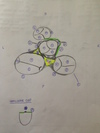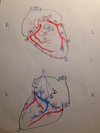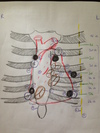Heart Flashcards
Briefly explain the portal circulation
- venous blood from unpaired abdominal organs (stomach, intestine, pancreas, spleen) absorbed by intestine
- carried to v. portae
- collected in capillary bed in liver
- collected by vv. hepaticae
- conveyed to v. cava inferior
1 - 5

1) apex cordis
2) basis cordis
3) sulcus coronarius
4) sulcus interventricularis anterior
5) sulcus interventricularis posterior
6 - 10
How is #8 called inside?

6) truncus pulmonalis
7) sinus trunci pulmonalis
8) conus arteriosus → inside: infundibulum cordis
9) atrium dextrum
10) ventriculus dexter
11 - 14

11) aorta
12) v. cava superior
13) auricula sinistra
14) auricula dextra
1 - 5

1) aorta ascendens
2) arcus aorticus
3) truncus pulmonalis
4) a. pulmonalis sinistra
5) truncus brachiocephalicus
6 - 10

6) a. carotis communis dextra
7) a. subclavia dextra
8) a. carotis communis sinistra
9) a. subclavia sinistra
10) lig. arteriosum
1 - 5

1) arcus aorticus
2) aorta descendens
3) aorta ascendens
4) truncus brachiocephalicus
5) a. carotis communis sinistra
6 - 10

6) a. subclavia sinistra
7) v. cava superior
8) a. pulmonalis dextra
9) a. pulmonalis sinistra
10) v. cava inferior
11 - 15

11) vv. pulmonales dextrae
12) vv. pulmonales sinistrae
13) atrium dextrum
14) atrium sinistrum
15) sulcus coronarius
16 - 20

16) sinus coronarius
17) sulcus terminalis
18) auricula sinistra
19) sinus transverus pericardii
20) ventriculus sinister
21 - 25

21) ventriculus dexter
22) sulcus interventricularis posterior
23) apex cordis
24) basis cordis
25) truncus pulmonalis
1 - 5

1) v. cava superior
2) v. cava inferior
3) sinus coronarius
4) vv. pulmonales dextrea
5) vv. pulmonales sinistrae
6 - 10
What forms #6?

6) crista terminalis → outside: sulcus terminalis
7) mm. pectinati
8) sinus venarum cavarum
9) valvula Eustachii
10) valvula Thebesii
11 - 15
Give another name for #11.

11) valva artrioventricularis dextra → tricuspid valve
12) chordae tendinae
13) m. pappilaris anterior
14) m. pappilaris septalis
15) m. pappilaris posterior
16 - 20
Give another name for #17.

16) trabeculae carnae
17) trabecula septomarginalis → moderator band
18) septum interventriculare pars muscularis
19) septum interventriculare pars membranacea
20) septum artrioventriculare
22 - 25
Give another name for #25.

22) septum interartriale
23) limbus fossae ovalis
24) fossa ovalis
25) valva artrioventricularis sinistra → bicuspid valve
26 - 28

26) m. pappilaris anterior
27) m. pappilaris posterior
28) thicker wall of right ventricle
Describe the structure of a semilunar valve
Give another name for the smallest part
- pars densa: lower part
- pars flaccida: upper part
- 2 lunuli: thickened edges
- 1 nodulus (=corpus Arantii): closes cusps
The inflow and outflow tract of the right ventricle are divided by.. ?
- crista supraventricularis
- trabecula septomarginalis
The inflow and outflow tract of the left ventricle is divided by.. ?
How is the structure called?
anterior cusp of bicuspid valve
→ vestibulum aortae
Which vessel leaves the left ventricle?
aorta
What are the 3 layers that make up the heart wall?
- endocardium
- myocardium
- epicardium
Which structures make up the myocardium?
- atrial muscle
- ventricular muscle
Differentiate btw atrial muscle layers
- deep layer: surrounding each atrium
- superficial layer: covers both atria
Differentiate btw ventricle muscle layers
- stratum subendocardiale: forms trabeculae carnae, mm. papillares, sulcus coronarius, sulcus interventricularis ant./post
- stratum musculare: only septum interventr., wall of left ventricle
- stratum subepicardiale: forms vortex cordis
Describe the structure of the endocardium
= continuation of inner layer of wall vessels, therefore:
- endothelium
- conn. tissue
Describe the structure and function of the epicardium
- mesothelium
- conn. tissue
- adipose tissue → smoothes unevenness of heart surface
What is the function of the cardiac skeleton?
- electrical insulation of atria/ventricles
- attachment site for:
- myocardium
- leaflets and cusps of valves
- keeps orifices of valves stable
1 - 5

1) valva atrioventricularis dextra
2) valva atrioventricularis sinistra
3) valva aortae
4) valva pulmonalis
5) cuspis anterior
6 - 10

6) cuspis posterior
7) cuspis commisuralis
8) cuspis anterior
9) cuspis posterior
10) cuspis septalis
11 - 15

11) cuspis semilunaris sinistra
12) cuspis semilunaris dextra
13) cuspis semilunaris posterior
14) cuspis semilunaris dextra
15) cuspis semilunaris anterior
16 - 22

16) cuspis semilunaris sinistra
17) sinus trunci
18 - 20) sinus aorticus
21) a. coronaria dextra
22) a. coronaria sinistra
23 - 27
Another name for #27?

23) anulus fibrosus dexter
24) anulus fibrosus sinister
25) tendo coni arteriosi
26) trigonum fibrosum dextrum
27) fasciculi atrioventricularis → bundle of HIS
28 - 30

28) trigonum fibrosum sinistrum
29) lunulus valvulae semilunaris
30) nodulus valvulae semilunaris
Where do the aa. coronaria originate from?
right + left semilunar valves of sinus aorticus (therefore: left ventricle)
Where does all the deoxigenated blood from the vv. coronaria gather?
Where does this structure drain into resp.?
sinus coronarius → right atrium
The veins of the heart form which structure on the posterior surface?
crux cordis
1 - 5

1) v. cava superior
2) truncus pulmonalis
3) aorta
4) v. cava inferior
5) apex cordis
6 - 11

6) apex cordis
8) a. coronaria sinistra
9) a. coronaria dextra
10) r. interventricularis anterior
11) r. interventricularis posterior
12 - 16

12) r. circumflexus
13) r. marginalis dexter
14) r. marginalis sinister
15) rr. atriales
16) r. atrialis anastomicus
17 - 21
Another name for #21?

17) rr. ventriculares
18) r. lateralis
19) rr. interventriculares septales
20) rr. atrioventriculares
21) v. obliqua atrii sinistra (= Marshall vein)
How is heart dominance determined?
Describe the variations
Determined by supply of r. interventricularis posterior and AV-node. Usually (70%) right dominance
- right dominance: supplied by a. coronaria dextra
- left dominance: supplied by r. circumflexus (of a. coronaria sinistra)
- co-dominance: supplied by both
22 - 25

22) v. cordis magna
23) sinus coronarius
24) v. cordis parva
25) v. cordis magna
What is the name of the structure btw v. pulmonalis dextra and right atrium?
Waterston’s groove
List the innervation/conduction of the heart step by step
- para-/sympathetic innervation pathway
- plexus cardiacus
- SA-node
- AV-node
- bundle of HIS
- crus dextrum/sinistrum
- Purkinje fibers, mm. papillares, myocardium
Which structures make up the sympathetic innervation pathway?
Where do they fuse?
What is their function?
Structures
- n. cardiacus cervicalis superior / medius / inferior
- rr. cardiaci thoraci
- ganglion stellatum (= fusion of inf. cerv. ganglion + first thoracic ganglion at C7 level)
→ fuse in plexus cardiacus
Function
increase heart rate
Which structures make up the parasympathetic innervation pathway?
Where do they fuse?
What is their function?
Structures
- n. vagus
- rr. cardiaci thoraci
→ fuse in plexus cardiacus
Function
decrease heart rate
How can plexus cardiacus be differentied?
Where are these parts located?
- superficial part: in front of a. pulmonalis dextra
- deep part: behind arcus aorticus
1 - 5
Another name for #1 - 3

1) nodus sinuatrialis (= SA-node)
2) nodus atrioventricularis (=AV-node)
3) fasciculus atrioventricularis (=bundle of HIS)
4) crus dextrum
5) crus sinistrum
6 - 8
Another name for #6

6) trabecula septomarginalis (= moderator-band)
7) Purkinje fibers
8) septum interventriculare pars muscularis
GIve different names for nodus sinuatrialis.
Where is it located?
- SA-node, cardiac pacemaker, Keith-Flack-node
- located in sulcus terminalis near SVC inlet, subepicardiacally
GIve different names for nodus atrioventricularis.
Where is it located?
It is innervated by.. ?
- AV-node, Aschoff-Tawara-node
- located in Koch’s triangle, sub-endocardially
- innervated by myocardium of right atrium
What are the borders of Koch’s triangle
- superiorly: tendon of Todaro
- inferiorly: tricuspid valve anulus
- posteriorly: valva Thebesii
What does the tendon of Todaro connect?
trigonum fibrosum dextrum → valva Eustachii
Give another name for fasciculus atrioventricularis.
Where is it located?
- bundle of HIS
- located in trigonum fibrosum dextrum
Give another name for crus dextrum/sinistrum.
Which structures are innervated by crus dextrum/sinistrum?
Name a special feature of crus dextrum and what does it innervate?
= right/left Tawara crus
- mm. papillares (through Purkinje fibers)
- myocardium
crus dextrum innervates trabecula septomarginalis → m. papillaris ant.
1 - 5
Give another name for #4

1) pericardium serosum → lamina parietalis/visceralis
2) pericardium fibrosum
3) porta arteriosa
4) porta venosa (= Sappey’s T)
5) truncus pulmonalis
6 - 10

6) aorta
7) vv. pulmonales dextrae
8) vv. pulmonales sinistrae
9) v. cava superior
10) v. cava inferior
11 - 15
What is the function of #13?
Which additional nerve not shown on the drawing innervates the pericardium?

11) sinus obliquus pericardii
12) n. phrenicus
13) a. + v. pericardiophrenica → blood supply of pericardium
14) n. vagus
15) lig. arteriosum
→ truncus sympathicus
16 - 18

16) centrum tendineum (caudal border)
17) cavitas pleuralis (lateral borders)
18) sinus transversus pericardii
What are the caudal, ventral, dorsal and lateral borders of the pericardium fibrosum?
It is attached to its ventral border by.. ?
- caudally: centrum tendineum
- ventrally: sternum (attached to by ligg. sternopericardiaca)
- dorsally: trachea, spine
- laterally: cavitas pleuralis
Why is the sinus transversus pericardii of clinical importance?
allows surgeon to his fingers in and applies a ligature to stop the circulation for example in heart transplantation surgeries
What is the average weight of a male and female heart resp.?
- female: 250-300g
- male: 300-350g
The mediastinum can be differentiated into..?
It is seperated by.. ?
List their contents.
- medastinum superius: thymus, blood vessels + nerve pathways
————- angulus sterni ————-
-
mediastinum inferius:
- mediastinum anterius: conn. tissue
- mediastinum medium: heart, pericardium, loose conn. tissue, corpus adiposum retrosternalis, lymph vessels
- mediastinum posterius: esophagus, large blood vessels + nerve pathways
1 - 5

1) facies sternocostalis
2) facies diaphragmatica
3) facies posterior cordis → mainly: left atrium
4) facies pulmonales
5) mediastinum posterius
6 - 10

6) mediastinum medium
7) mediastinum anterius
8) pericardium
9) heart
10) esophagus
12 - 14

12) lung
13) pleura / cavitas pleuralis
14) radix pulmonis
Why does the close relation of the left atrium to the esophagus have a clinical importance?
stenosis of mitral valve → enlargement left atrium → compression of esophagus → dysphagia
What is auscultation?
Where can it be done best?
- listening to heart sounds
- best heard at point on thoracic wall closest to regarding valve → auscultation sites
Give the location of the auscultation sites of the valves.
Give the location of another very famous auscultation site and explain when it is used.
- valva aortae: right 2nd interc. space, parasternally
- valva pulmonalis: left 2nd interc. space, parasternally
- bicuspid valve: left 5th interc. space, midclavicular line
- tricuspid valve: right 5th interc. space, parasternally
- punctum quintum: (= Erb’s point) left 3rd interc. space, parasternally, esp. high freq. sounds of insufficient valva aortae / pulmonalis
When can the heart sounds be heard?
Pathological heart sounds can be produced by.. ?
- 1st heart sound: contraction phase of systole
- 2nd herat sound: beginning diastole → closure of cuspes semilunares aortae, trunci pulmonali
- pathological heart sounds: can be produced by stenosis / valvular insufficiency
List the different percussion sounds and where they can be heard
- absolute cardiac dullness: at sternum
- relative cardiac dullness: at any other point of heart that is covered by lung tissue
- “undamped” sound: at “pure” lung tissue
1 - 5

1) intercostal space
2) sulcus coronarius, left edge
3) apex cordis
4) sulcus coronarius, right edge / v. cava inferior, right margin
5) v. cava superior, right margin
6 - 10

6) 2 cm
7) midclavicular line
8) 2 cm
9) 2 cm
10) right atrium
11 - 15
Give another name for #12

11) v. cava superior
12) arcus aorticus, aortic knuckle
13) truncus pulmonalis
14) auricula sinistra
15) left ventricle
16 - 20
Give another name for #18

16) auscultation site: valva aortae
17) auscultation site: valva pulmonis
18) auscultation site: punctum quintum (= Erb’s point)
19) auscultation site: bicuspid valve
20) auscultation site: tricuspid valve
21 - 23

21) valva trunci pulmonis/aortae
22) bicuspid/tricuspid valve
23) sulcus coronarius


